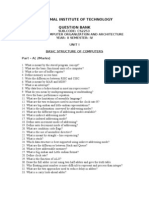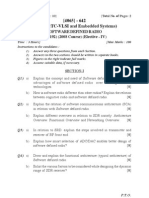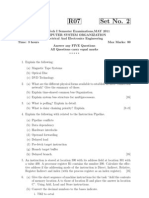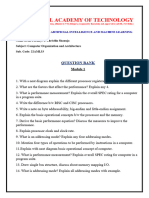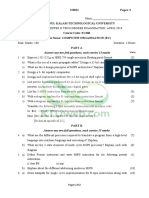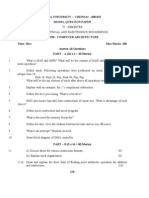WWW - Indiastudents.in: Question Paper Code
WWW - Indiastudents.in: Question Paper Code
Uploaded by
Behin SamCopyright:
Available Formats
WWW - Indiastudents.in: Question Paper Code
WWW - Indiastudents.in: Question Paper Code
Uploaded by
Behin SamOriginal Description:
Original Title
Copyright
Available Formats
Share this document
Did you find this document useful?
Is this content inappropriate?
Copyright:
Available Formats
WWW - Indiastudents.in: Question Paper Code
WWW - Indiastudents.in: Question Paper Code
Uploaded by
Behin SamCopyright:
Available Formats
Reg. No.
:
B.E./B.Tech. DEGREE EXAMINATION, APRIL/MAY 2010
Fourth Semester
Computer Science and Engineering
CS2253 COMPUTER ORGANIZATION AND ARCHITECTURE
(Common to Information Technology)
(Regulation 2008)
Time: Three hours Maximum: 100 Marks
Answer ALL Questions
PART A (10 2 = 20 Marks)
1. Distinguish between autoincrement and autodecrement addressing mode.
2. Compare RISC with CISC architecture.
3. Under what situations the micro program counter is not incremented after a
new instruction is fetched from micro program memory?
4. What are the relative merits of horizontal and vertical microinstruction
format?
5. What is pipelining and what are the advantages of pipelining?
6. List the key aspects in gaining the performance in pipelined systems.
7. How many memory chips are needed to construct 2 M 16 memory system
using 512 K 8 static memory chips?
8. What is virtual memory and what are the benefits of virtual memory?
9. What is meant by bus arbitration?
10. Name and give the purpose of widely used bus standard.
PART B (5 16 = 80 Marks)
11. (a) (i) Describe the role of system software to improve the performance of
a computer. (8)
(ii) Design a 4-bit adder/subtracter circuit using full adders and explain
its function. (8)
Or
(b) (i) What are the special registers in a typical computer? Explain their
purposes in detail. (8)
(ii) Design a 4-bit fast adder and explain its function in detail. (8)
Question Paper Code: E3065
w
w
w
.
i
n
d
i
a
s
t
u
d
e
n
t
s
.
i
n
E 3065
2
12. (a) (i) Draw and explain the block diagram of a complete processor. (6)
(ii) Briefly describe the design of a hardwired control unit. (10)
Or
(b) (i) Explain the basic organization of a microprogrammed control unit
and the generation of control signals using microprogram. (12)
(ii) What are the advantages and disadvantages of hardwired and
microprogrammed control? (4)
13. (a) (i) Describe the role of cache memory in pipelined system. (8)
(ii) Discuss the influence of pipelining on instruction set design. (8)
Or
(b) What is instruction hazard? Explain the methods for dealing with the
instruction hazards. (16)
14. (a) (i) What are the different secondary storage devices? Elaborate on any
one of the devices. (8)
(ii) Explain how the virtual address is converted into real address in a
paged virtual memory system. (8)
Or
(b) (i) Explain approaches for addressing multiple-module memory
systems with suitable diagrams. (6)
(ii) Briefly describe magnetic disk principles and also the organization
and accessing of data on a disk. (10)
15. (a) (i) Describe the hardware mechanism for handling multiple interrupt
requests. (8)
(ii) What are handshaking signals? Explain the handshake control of
data transfer during input and output operation. (8)
Or
(b) (i) What are the needs for input-output interface? Explain the
functions of a typical 8-bit parallel interface in detail. (10)
(ii) Describe the USB architecture with the help of a neat diagram. (6)
w
w
w
.
i
n
d
i
a
s
t
u
d
e
n
t
s
.
i
n
You might also like
- Coa Important QuestionsDocument5 pagesCoa Important QuestionsGanesh Babu100% (2)
- Exploring BeagleBone: Tools and Techniques for Building with Embedded LinuxFrom EverandExploring BeagleBone: Tools and Techniques for Building with Embedded LinuxRating: 4 out of 5 stars4/5 (1)
- PART A - (10 × 2 20 Marks)Document2 pagesPART A - (10 × 2 20 Marks)Deepak TirunelveliNo ratings yet
- CS2253 - Computer Organization and Architecture PDFDocument2 pagesCS2253 - Computer Organization and Architecture PDFvelkarthi92100% (1)
- Coa Question PapersDocument2 pagesCoa Question PapersPavithra DeepikaNo ratings yet
- Anna University QP COADocument3 pagesAnna University QP COAAbirami Satheesh KumarNo ratings yet
- Question Paper Code:: Sri Vidya College of Engineering & Technology, Virudhunagar Course Material (University Question)Document2 pagesQuestion Paper Code:: Sri Vidya College of Engineering & Technology, Virudhunagar Course Material (University Question)rajesh5500No ratings yet
- EC2303 Computer Architecture and Organization QUESTION PAPERDocument4 pagesEC2303 Computer Architecture and Organization QUESTION PAPERJayagopal JaiNo ratings yet
- B - E / B - T E C H (Full-Time) D E G R E E Examinations, April/May 2012Document2 pagesB - E / B - T E C H (Full-Time) D E G R E E Examinations, April/May 2012krithikgokul selvamNo ratings yet
- Computer Architecture Question BankDocument10 pagesComputer Architecture Question BankMalk Malik0% (1)
- Computer Architecture Question BankDocument10 pagesComputer Architecture Question BankaniprahalNo ratings yet
- Computer Architecture Question BankDocument7 pagesComputer Architecture Question BankSalma Mehajabeen ShajahanNo ratings yet
- CS 2354 - Advanced Computer Architecture PDFDocument2 pagesCS 2354 - Advanced Computer Architecture PDFvelkarthi92100% (1)
- Cs1358 Ece Computer ArchitectureDocument8 pagesCs1358 Ece Computer ArchitectureMarimuthu MuthaiyanNo ratings yet
- X62303 (CS1251 Cs1202a)Document2 pagesX62303 (CS1251 Cs1202a)tamilarasi87thulasiNo ratings yet
- Computer Architecture & OrganizationDocument4 pagesComputer Architecture & OrganizationUma MaheswariNo ratings yet
- Embedded System - J7607Document2 pagesEmbedded System - J7607ustadkrishnaNo ratings yet
- Es Model QPDocument13 pagesEs Model QPலோகேஷ் கிருஷ்ணமூர்த்திNo ratings yet
- CS2354 Advanced Computer Architecture Anna University Question Paper For MEDocument2 pagesCS2354 Advanced Computer Architecture Anna University Question Paper For MEpraveenaprabhuNo ratings yet
- Question Bank - M5 To M7Document2 pagesQuestion Bank - M5 To M7Pieter MarkerNo ratings yet
- Cao Imp QuestionsDocument1 pageCao Imp QuestionsYuvaperiyasamy MayilsamyNo ratings yet
- CS2253 - Coa - Univ QNSDocument6 pagesCS2253 - Coa - Univ QNSKristyn BlackNo ratings yet
- Erts - Model 1Document3 pagesErts - Model 1Ece DeptNo ratings yet
- Question Paper CodeDocument2 pagesQuestion Paper CodesaipriyaNo ratings yet
- WWW - Indiastudents.in: Question Paper CodeDocument2 pagesWWW - Indiastudents.in: Question Paper CodeBehin SamNo ratings yet
- Computer Organization Ii Mid Question Bank Ii Cse Ii Sem UNIT-5Document1 pageComputer Organization Ii Mid Question Bank Ii Cse Ii Sem UNIT-5Vamsinath JavangulaNo ratings yet
- CS9211-Computer Architecture QuestionDocument7 pagesCS9211-Computer Architecture Questionrvsamy80No ratings yet
- Unit-I: Sub: Computer Organisation and Architecture Unit Wise Important QuestionsDocument5 pagesUnit-I: Sub: Computer Organisation and Architecture Unit Wise Important QuestionsManju Reddy PalakolluNo ratings yet
- Computer Organzation and Architecture Question BankDocument10 pagesComputer Organzation and Architecture Question Bankmichael100% (2)
- Ece 309 BDocument2 pagesEce 309 BMahakNo ratings yet
- Adv. Computer Architecture CS701 - Jan 011Document2 pagesAdv. Computer Architecture CS701 - Jan 011Sachin Kumar GoyelNo ratings yet
- Cs2253 Computer Organization and Architecture Question BankDocument10 pagesCs2253 Computer Organization and Architecture Question BankVenkat RamNo ratings yet
- CAO 2021 Assignment QuestionDocument9 pagesCAO 2021 Assignment Questiondawit tadewoseNo ratings yet
- Set No. 1Document7 pagesSet No. 1Dinesh Padma Rao KadiyamNo ratings yet
- NR Set No. 2Document4 pagesNR Set No. 2adddataNo ratings yet
- Es Model ExamDocument3 pagesEs Model ExamAarun ArasanNo ratings yet
- Computer Architecture (CSE-201, Dec-07) Section-ADocument1 pageComputer Architecture (CSE-201, Dec-07) Section-AsandeepaprNo ratings yet
- 5 Oct11Document12 pages5 Oct11Manu SeaNo ratings yet
- Computer Architecture Question Anna UniversityDocument2 pagesComputer Architecture Question Anna UniversitymashaNo ratings yet
- CAO 2018 T3 Question PaperDocument2 pagesCAO 2018 T3 Question Paperharsh guptaNo ratings yet
- IT1353 Embedded SystemDocument6 pagesIT1353 Embedded SystemReeshma ApNo ratings yet
- Computer Architecture and OrganizationDocument6 pagesComputer Architecture and OrganizationRahmantic SwatzNo ratings yet
- ArchitectureDocument3 pagesArchitecturesamueljamespeterNo ratings yet
- R07 Set No. 2Document7 pagesR07 Set No. 2Mothilal KaramtothuNo ratings yet
- Question Bank - Embedded SystemDocument8 pagesQuestion Bank - Embedded Systemsrk1121srkNo ratings yet
- Top 20 Cim QuestionsDocument2 pagesTop 20 Cim QuestionsAnonymous WmMP8H6JGNo ratings yet
- Coa QBDocument6 pagesCoa QBsourabha prasadNo ratings yet
- Answer Any Two Full Questions, Each Carries 15 Marks: Reg No.: - NameDocument2 pagesAnswer Any Two Full Questions, Each Carries 15 Marks: Reg No.: - NameAmal Chandran MVNo ratings yet
- MCS 012Document4 pagesMCS 012rajatkumar.codingNo ratings yet
- Global Academy of Technology: Question BankDocument6 pagesGlobal Academy of Technology: Question Banksourabha prasadNo ratings yet
- Anna University:: Chennai - 600 025 Model Question PaperDocument2 pagesAnna University:: Chennai - 600 025 Model Question PaperSwathi RajagopalNo ratings yet
- ComputerArch Nov2014Document1 pageComputerArch Nov2014Vikas SyalNo ratings yet
- Question Paper Computer FundamentalsDocument5 pagesQuestion Paper Computer Fundamentalsshivscribd1100% (1)
- Camp Que BankDocument36 pagesCamp Que BankDiya ShahNo ratings yet
- EE6602 Embedded SystemsDocument6 pagesEE6602 Embedded SystemsdsvinodhNo ratings yet
- End Term Examination: Paper Code: BBA - 107 Subject: Computer Fundamentals Paper IDDocument5 pagesEnd Term Examination: Paper Code: BBA - 107 Subject: Computer Fundamentals Paper IDshivscribd1No ratings yet
- Question Paper Code:: Reg. No.Document2 pagesQuestion Paper Code:: Reg. No.rajkumarsacNo ratings yet
- QP April 2024 EvenDocument4 pagesQP April 2024 EvenG.AkshayaNo ratings yet
- Electronic Structure Calculations on Graphics Processing Units: From Quantum Chemistry to Condensed Matter PhysicsFrom EverandElectronic Structure Calculations on Graphics Processing Units: From Quantum Chemistry to Condensed Matter PhysicsRoss C. WalkerNo ratings yet
- Friend Based Trust Recommendation Model For Secure Quality of Service Aware Routing in ManetDocument5 pagesFriend Based Trust Recommendation Model For Secure Quality of Service Aware Routing in ManetBehin SamNo ratings yet
- Friend Based Trust Recommendation Model For Secure Quality of Service Aware Routing in ManetDocument5 pagesFriend Based Trust Recommendation Model For Secure Quality of Service Aware Routing in ManetBehin SamNo ratings yet
- 304 9 ER To Relational By6Document6 pages304 9 ER To Relational By6Behin SamNo ratings yet
- University of Madras: Syllabus For The Courses On Softskills (W.e.f. 2007 2008)Document33 pagesUniversity of Madras: Syllabus For The Courses On Softskills (W.e.f. 2007 2008)Behin SamNo ratings yet
- Cs2253 Coa SyllabusDocument1 pageCs2253 Coa SyllabusBehin SamNo ratings yet
- Module 2 - Sample Delay CalculationsDocument2 pagesModule 2 - Sample Delay CalculationsBehin SamNo ratings yet
- WWW - Indiastudents.in: Question Paper CodeDocument2 pagesWWW - Indiastudents.in: Question Paper CodeBehin SamNo ratings yet
- The Moment Generating Function of The Binomial Distribution: Msc. Econ: Mathematical Statistics, 1996Document3 pagesThe Moment Generating Function of The Binomial Distribution: Msc. Econ: Mathematical Statistics, 1996Behin SamNo ratings yet
- Handbook TNSCBDocument208 pagesHandbook TNSCBBehin SamNo ratings yet
- Laptop Motherboard Component Overview PartIDocument23 pagesLaptop Motherboard Component Overview PartIBehin Sam88% (8)
- Upload ReturnDocument1 pageUpload ReturnBehin SamNo ratings yet
- Collection of DataDocument18 pagesCollection of DataBehin SamNo ratings yet
- RISC Vs CISCDocument13 pagesRISC Vs CISCBehin SamNo ratings yet
- Centre For Professional Development EducationDocument3 pagesCentre For Professional Development EducationBehin SamNo ratings yet
- Application For External GuideDocument3 pagesApplication For External GuideBehin SamNo ratings yet
- 8U5CSSB - Software Engineering QSDocument2 pages8U5CSSB - Software Engineering QSBehin SamNo ratings yet
- M E System-ORDocument38 pagesM E System-ORBehin SamNo ratings yet
- Anritsu MF160xADocument3 pagesAnritsu MF160xAJosue PazNo ratings yet
- Interface Between Sustainable Development Law and Intellectual Property ProtectionDocument9 pagesInterface Between Sustainable Development Law and Intellectual Property ProtectionZeeshan RazviNo ratings yet
- PH100 Tutorial 02Document3 pagesPH100 Tutorial 02Yash SinghNo ratings yet
- Nme Hampir FixDocument88 pagesNme Hampir Fixellysa lovianiNo ratings yet
- UPSDocument8 pagesUPSMohammed Sayeeduddin100% (1)
- Current Trends in Bumper Design For Pedestrian ImpactDocument16 pagesCurrent Trends in Bumper Design For Pedestrian ImpactVikas VNo ratings yet
- Acknowledgment For Request For New PAN Card (Form 49A)Document2 pagesAcknowledgment For Request For New PAN Card (Form 49A)Rajneesh PerhateNo ratings yet
- Review 4 - Lesson 7+8Document11 pagesReview 4 - Lesson 7+8thucptNo ratings yet
- 250.122 (B) Size of Equipment Grounding Conductors. Increased in SizeDocument3 pages250.122 (B) Size of Equipment Grounding Conductors. Increased in Sizeerson1981No ratings yet
- High Density Plasma Sources PopovDocument6 pagesHigh Density Plasma Sources Popovbad_mariussNo ratings yet
- Lot 1-C, (LRC) PSD-155804 - SKPDocument1 pageLot 1-C, (LRC) PSD-155804 - SKPAnnabelle ParNo ratings yet
- Cau Hoi On Tap Dien Dien Tu EngDocument10 pagesCau Hoi On Tap Dien Dien Tu Engthang nguyenNo ratings yet
- LSG-E SeriesClamping Force 35 ~ 950Togglels乐星注塑机Document17 pagesLSG-E SeriesClamping Force 35 ~ 950Togglels乐星注塑机1648183658No ratings yet
- Fuel Retention Sample ContainersDocument2 pagesFuel Retention Sample ContainersSarbast H. SaeedNo ratings yet
- 23145879Document5 pages23145879Ali Ben AmorNo ratings yet
- Pims BriefDocument5 pagesPims BriefPriya ChaudharyNo ratings yet
- DCVDocument35 pagesDCVTanoj Patro100% (1)
- Abener: Optimization Techniques in Engineering and Construction of A Bioethanol PlantDocument14 pagesAbener: Optimization Techniques in Engineering and Construction of A Bioethanol PlantWael_Barakat_3179No ratings yet
- CV PDF 3Document4 pagesCV PDF 3api-310256546No ratings yet
- General Tolerances - DIN ISO 2768Document2 pagesGeneral Tolerances - DIN ISO 2768Paulo Ferrari Tapie100% (2)
- BIOLOGY f4 Chapter1Document21 pagesBIOLOGY f4 Chapter1Kar KuanNo ratings yet
- Kathrein 80010303 PDFDocument3 pagesKathrein 80010303 PDFEmmersonLisboaNo ratings yet
- Method StatementDocument4 pagesMethod StatementSheeraz AliNo ratings yet
- Smiths6040 2is#4Document2 pagesSmiths6040 2is#4FacturaciónDVDNo ratings yet
- 7 Bmba Sumergible LowaraDocument60 pages7 Bmba Sumergible LowaraHugo Miño CarrascoNo ratings yet
- SEV Application FormDocument4 pagesSEV Application FormHieuNo ratings yet
- A Project Report On Consumer Satisfaction of Buying Behavior On Men'S Apparel in Reliance TrendsDocument12 pagesA Project Report On Consumer Satisfaction of Buying Behavior On Men'S Apparel in Reliance TrendsAnutosh DuttaNo ratings yet
- SQL Server ReplicationDocument4 pagesSQL Server ReplicationrajakumariNo ratings yet
- Cloud MigrationDocument12 pagesCloud MigrationPrashant PanseNo ratings yet
- Catalogue Hitachi Lift OUG ON1Document30 pagesCatalogue Hitachi Lift OUG ON1Dak SerikNo ratings yet




























